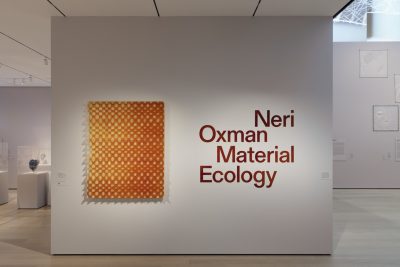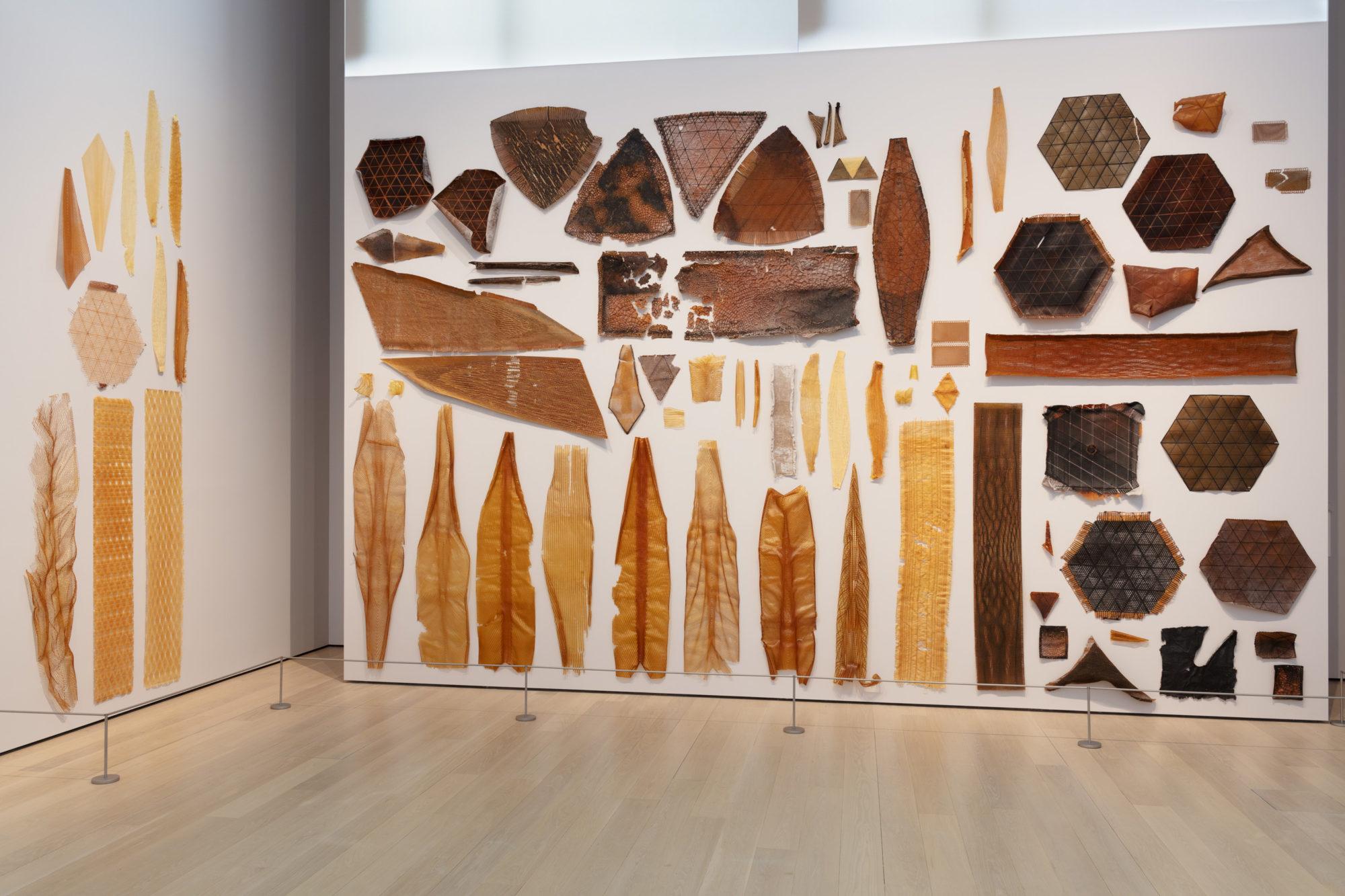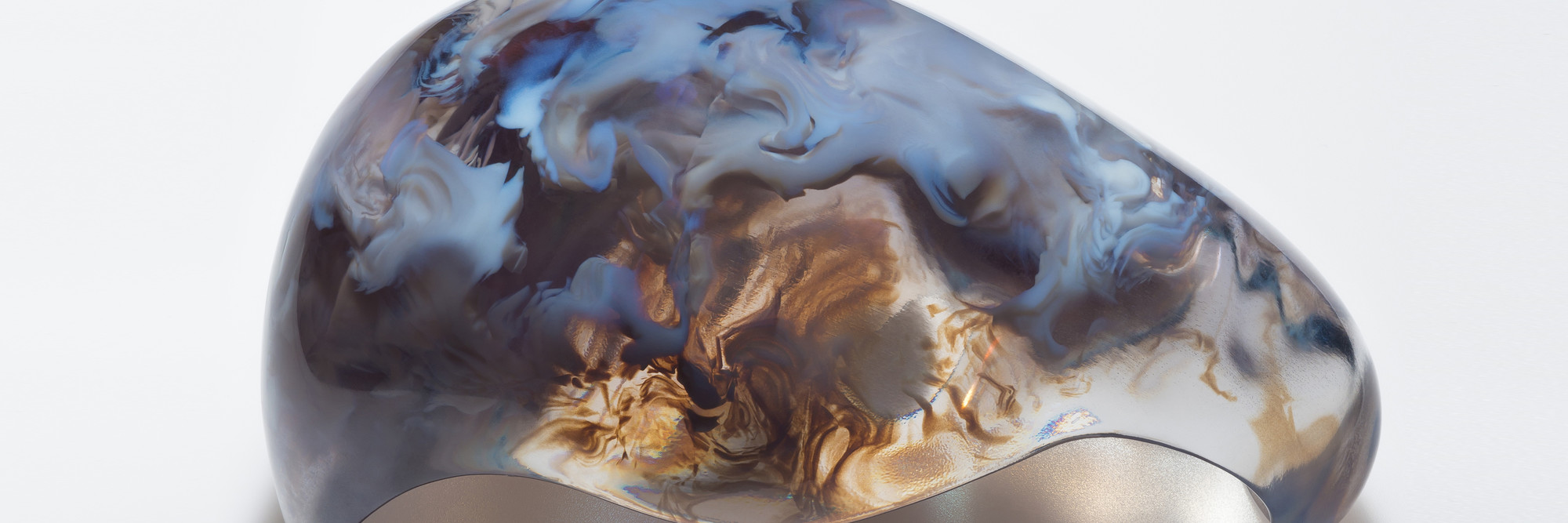“Material Ecology”: Neri Oxman at the New York Museum of Modern Art

New York’s Museum of Modern Art is currently exhibiting Material Ecology, a tantalizing sample of the truly astounding and path-breaking work of Neri Oxman and her team, Mediated Matter group, at the Massachusetts Institute of Technology.
Oxman is an American-Israeli architect and designer – yet these designations conspicuously fail to capture the utterly novel field which Oxman’s work is exploring, defining and re-defining. Every item in the show may be viewed as a “demonstration of new materials and new processes, as a door into a new way of designing and making.” Her inter-disciplinary work bridges engineering, biology and computer science – while addressing itself to both timely and timeless epistemological and ethical issues.
Oxman’s epistemic interventions testify to, welcome, and embrace a new concept of what knowledge is and how it emerges: “Knowledge can no longer be ascribed to, or produced within, disciplinary boundaries, but is entirely entangled.” In other words, Oxman’s work – both theoretically and materially – lies at the very forefront of human understanding: Oxman and her team are inventing not only new kinds of objects, and the technologies which makes such objects possible – they are inventing a new, holistic field altogether, re-making the very boundaries of human disciplines. In the process, they are creating new, interdependent modes of knowledge; new forms of experience and new ways of living or being in the world.
Neri Oxman and her team at MIT refer to the field which they have created as Material Ecology: an “emerging field in design denoting informed relations between products, buildings, systems, and their environment.” Hence, Oxman’s push towards “universal synthesis” – material ecology’s integrating, harmonizing, and tapping into multiple disciplines in its approach to design – remains conscious of the ethical entanglement with our environment. Their work consistently emphasizes “environmentally informed digital design and fabrication.” These often visually stunning designs can take the form of extrusions – materials that have been thrust out by an animal or machine; or intrusions – 3D-printed objects engineered to be infused with organic material, such as melanin or bacteria.
Oxman’s posits a nevalogue – a kind of moral shorthand that clarifies the ethical commitments of Material Ecology. A few of these principles are of special significance. For the practicing material ecologist, the client is always first and foremost nature itself: “The natural environment at large constitutes the ‘client’ for every commissioned project, as well as its ‘site’ and material source.” We can and must take Oxman at her word here: in a certain sense her designs are meant to let nature realize its own inherent telos, its own intrinsic ends, and its own interests.
Consider, for example, the Silk Pavilion – on display at the exhibition – that employed 17,000 silkworms in its fabrication, a thoroughly astonishing example of inter-species collaboration. Oxman positively envisions the partnership with other species as part of the repertoire of sustainable construction methods as we enter a new era of ecologically conscious architecture and design. Silk Pavilion is remarkable both because Oxman and her team were able to modify the worms’ spinning patterns, so that they spun in sheets rather than cocoons, and because they did not utilize the traditional method of boiling the larvae alive in their cocoon to extract the silk thread. Rather, their process allowed the silkworms to pass through the entire cycle of metamorphoses and live out their lives unharmed.
Many of the “demos” on display in this show are full of a weird and wonderful beauty. But what is most striking is that they represent a vision of the future, novel ways of designing our environments. At the same time, this radically new material ecology is anchored throughout by an ethical awareness – inseparable from an ethic of interanimality and interspecies cooperation. Oxman and her team are collaborating with living nature, the living material world, in the creation of what are ultimately new, transcendentally beautiful, and environmentally sustainable structures with the potential for large-scale applications. Their work also presents us with the fruits of a holistic conception of the organism as inherently expressive, valuable, and tending towards creative and ontological expansion.
Another principle of Material Ecology is that it prioritizes integration over segregation. Consider the traditional facade of a building: it is constructed out of discrete parts each of which serves a distinct function. Hard, rigid materials make for the exterior shielding or shell; while supple and yielding materials serve for comfort and insulation; and, finally, translucent materials allow the structure to communicate with the environment. Human skin, by contrast, utilizes generally the same material constituents over the entire body: smaller pores and thicker skin act as a barrier; larger pores and thinner skin for filtering, such as on the face. Distinct functions, in other words, are integrated rather than segregated, unified into “a single material system that can at any point respond and adapt to its environment.”
This ideal façade – able to modify itself in response to changes in the environment – is the motivation behind the “Totems” installation which utilizes melanin (the compound in skin pigmentation). Oxman envisions melanin’s use in architecture to produce optical variations in a building’s façade, depending on the time of day or season. The Totems demo, produced by injecting liquid melanin into a 3D-printed transparent block to manifest flesh-colored curls and plumes, is like so much in the exhibition, captivating, wonderful and strange.
Material Ecology seeks to produce “smart objects that respond to their environment and function more like bodies than manufactured entities, accommodating multiple functions rather than just one.” The “Armour” demo is a case in point: it is Oxman’s answer to the classic I-beam, a ubiquitous and fundamental component in modern architecture and an unmistakable symbol of the Industrial Revolution. The exhibition offers us only a small-scale prototype, but the idea is clear enough: Oxman’s Armour is effectively a beam designed to function as both skin and structure simultaneously. “Stiff structural components are embedded in a soft skin” – so that the design is capable of carrying vertical, horizontal, and rotational loads, while the beam’s sectional profile and structural thickness can be modified according to the anticipated load.
Material Ecology represents an approach to design that is non-human centered. This principle carries many implications, but it is central for grasping the ethical achievement of Oxman and Mediated Matter. As Oxman observes, “The group considers all living creatures as equals.” The aim is “to shift human-centric design to a design culture focused on conserving, improving and augmenting the natural environment through novel technological developments.” In short, material ecology breaks decisively with the kind of anthropocentrism which has led to untold environmental devastation and the irretrievable loss of countless species, and instead adopts a lateral rather than hierarchical relationship to non-human others.
Oxman’s approach to design is ultimately an embrace of “co-culture over single organism culture.” This fundamental ethical principle requires not only the recognition of biodiversity but underscores our entanglement and the ineliminable inter-dependency among individuals and species. Material Ecology offers us a way into the future that answers some of our deepest needs, and the needs of the countless species with which we share this planet. It posits a way of addressing some of our gravest environmental concerns – and does so by harnessing the creative energy that unites all Life. The mutual, inter-species collaboration which Oxman envisions has the potential to transform the face of our cities and communities, and to imbue them with an almost other-worldly yet natural beauty. As we hurtle towards an uncertain future, Oxman’s vision suggests a way of interacting with and reshaping our world that we need now more than ever.
*
Note to readers: please click the share buttons above or below. Forward this article to your email lists. Crosspost on your blog site, internet forums. etc.
Sam Ben-Meir is a professor of philosophy and world religions at Mercy College in New York City.
Featured image is from moma.org



